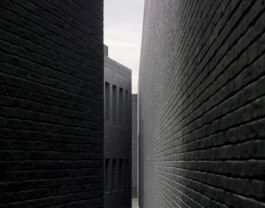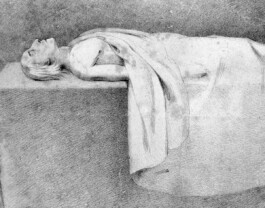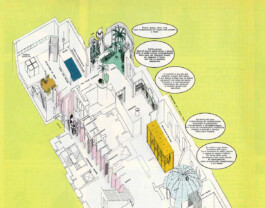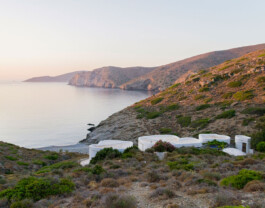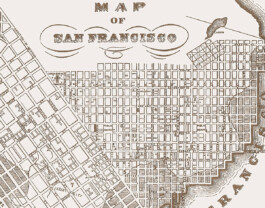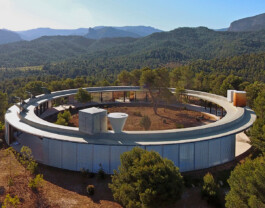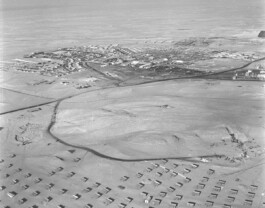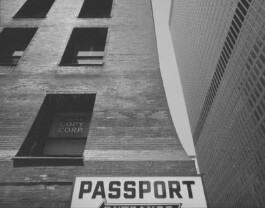Articles
At Flat Out, we take our architecture personally. We’ve selected a mix of essays, letters, editorials, and reviews by characters from past Flat Out issues for your leisurely perusal—updated periodically. To explore the full cast of characters and their writings, order our print editions here.

The
Cameo
Easier Done Than Said
Fall 2016
…A terrific number of things were done without any unifying thought, all in the belief that when you don’t have an idea you can conceal the fact just by multiplying the instruments.
It’s hard to imagine being disloyal to New York or Los Angeles. They contain too much, and no one ever mistakes a part as representative of the whole. Equally, they play host to worlds (fashion, finance, and art, or entertainment and technology) that are larger and more globally connected than their nominal urban address. Chicago, on the other hand, is more like John Carpenter’s Thing: every cell is the entirety, and it’s the only game in town.

The
Challenger
Dear Renato,
Fall 2016
Flat Out asked me to write to a contemporary architect about a recently completed building. It was not difficult to choose. The Shakespeare Theatre in Gdańsk, Poland, that you recently completed (which, as you remember, was built from 2008 to 2014 after a competition you won in 2005) is probably the best building by an Italian architect since Giorgio Grassi’s restoration of the Roman theater in Sagunto (1985–93). My congratulations.

The
Mortician
Death at One’s Elbow
Fall 2016
They call it “the law of the instrument”: to a carpenter with a hammer, every problem is a nail. In my line of work it is recently deceased things. Bodies of all shapes, sizes, and ages, lives drained from their mortal form, come through the swing doors at the back of the mortuary. To someone like myself, for whom the whiff of embalming fluid is never far away, it seems (as Morrissey once put it) that “in the midst of life we are in death et cetera.”.

The
Outsider
Hanging Around with Architects
Fall 2016
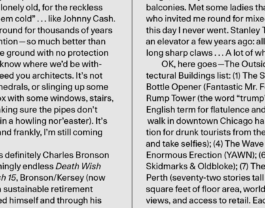
I’m from outside the ecstatic, cathartic, sex-crazed roller coaster ride you refer to as modern architectural practice. I’m from the dreary, monotonous, and functional world of rock and roll. Basically, I just hang around with architects. I married in. Some would say up! Sure, I wear black (and I own a pair of ludicrously expensive designer spectacles), but “I wear it for the sick and lonely old, for the reckless ones whose bad trip left them cold”… like Johnny Cash.
Coming Soon

The
Editor
What Have We Done?
Spring 2017
A recent study published in the science journal PLOS One found that people are more successful at producing original solutions and practicing risk-taking when they take on a stereotypically uninhibited perspective. When it came to accessing one’s “unconscious mind,” the effect of adopting a persona was as powerful as resting and napping. In other words, assuming the role of a character stimulates new insights and surprising creativity. At Flat Out, we were encouraged to learn that our cause was supported by their results.

The
Opinionator
How to Write an Exhibition Review
Spring 2017
These are sorry times for the architectural exhibition review. So many offer sanctimonious platitudes instead of criticism. Too few pass judgment. Perhaps this is why an extraordinary number of academics, art directors, curators, mayors, and public relations consultants have leapt to embrace the exhibition format as a promotional tool. Reviewers are unlikely to hold them accountable.

The Political
Economist
The Ground Game
Spring 2017
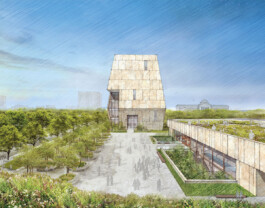
Until quite recently, the Obamas owned just one house, a red-brick Georgian Revival foursquare, circa 1911. It sits on the northern border of Hyde Park, a neighborhood on Chicago’s South Side that is also home to the University of Chicago. Ten blocks south, on Hyde Park’s southern border, is Eero Saarinen’s University of Chicago Law School (1959), a precise modernist ensemble of glass and concrete, where Barack Obama taught constitutional law for twelve years while he built his political career.
Coming Soon

The Talent
Agent
Pure, Archaic, and Absolute
Spring 2017
Secluded in an arid cove, sensuously curvilinear, and hard to find, the François-Bernard Mâche vacation house in Amorgos, Greece, is an architectural hidden gem. Designed by Iannis Xenakis in 1966, this outstanding piece has been obscured in the biography of one of the most idiosyncratic and influential composers of the twentieth century. A founding member of musique concrète, Xenakis also left an exemplary mark on modern architecture.

The
Muckraker
Die Techie Scum
Fall 2018
Douglas Rushkoff’s best-selling 2016 book, Throwing Rocks at the Google Bus, begins with an act of social protest: “One December morning in 2013, residents of San Francisco’s Mission District laid their bodies in front of a vehicle to prevent its passage. Although acts of public protest are not unusual in California, this one had an unlikely target: the Google buses used to ferry employees from their homes in the city to the company’s campus in Mountain View, thirty miles away.”

The
Scorekeeper
NOT A HOUSE
Fall 2018
In their Solo House, completed in 2017 in Mataraña, Teruel Aragón, Spain, the Belgian firm OFFICE Kersten Geers David Van Severen offers up a radical solution to the problem of mounting a view. This is the second built case from a collection of twelve “Solo Houses.” The first is a project by Pezo von Ellrichshausen, a Chilean studio founded by Mauricio Pezo and Sofia von Ellrichshausen. The Scorekeeper narrates his first impressions.

You
All Eyes on You
Fall 2018
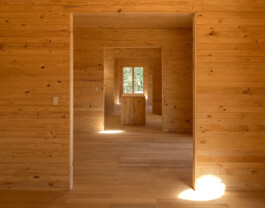
You close the door to the children’s bedroom behind you and lock it quietly. The door to the living room must be locked as well, and the door to your bedroom. Finally, you lock the glazed doors to outside. Only then are you alone. You put the toilet seat cover down. Extending your tired limbs, you watch the sun from the skylight hit your glass of wine, on the vanity in the center of the room. You gaze at the trees above the embankment through the doors.
Coming Soon

The
Genealogist
East of Eden
Spring 2020
In June 1947, Harold Corsini, a twenty-eight-year-old photographer from the public relations division of the Standard Oil Company of New Jersey (SONJ), made his way to four sites on the eastern coast of Saudi Arabia to document the modern materials and methods of labor, housing, and education that oil corporations had brought to the region. As a former economics professor who had previously served as the director of the Farm Security Administration’s documentary photography program, Stryker had helped shape the image of rural poverty during the Great Depression.

The
Inventor
Imagine a Completely New Color
Spring 2020
In August 2017, at the height of Hurricane Harvey, the United States National Weather Service was pushed to add two shades of purple—an extreme violet and a surprisingly subtle lavender—to the previous full-bodied-Malbec max on their color-coded weather maps of southeast Texas, in order to adequately represent the unprecedented rainfall the unprecedented rainfall unleashed by the storm.

The Odd
Couple
Wood / Not Wood
Spring 2020
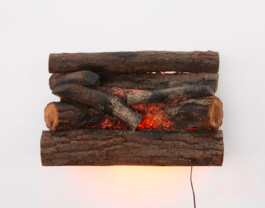
Oscar has curated and crafted a set of objects out of thrift-store detritus, slightly modified found objects, and original works of art. Oscar and Felix discuss these expressions of and in wood over the telephone.
Felix You’ve been collecting these wooden things for a while. Could you explain your idea of authenticity?
Oscar There’s a store I remember from a certain point in time, maybe ten years ago, that sold only oak furniture. The name of the store was the King of Solid Oak. I also lived with two guys who were cabinetmakers, and they would tell me that people wanted cabinets made out of solid wood rather than plywood. They thought plywood was kind of fake.
Coming Soon

The Odd
Couple
Same Building Twice
Fall 2025
For this installment of “The Odd Couple,” Felix and Oscar meditate on a 1974 photograph of the Monadnock Building and the Kluczynski Federal Building taken by William S. Engdahl for Hedrich-Blessing, the Chicago-based architectural photography studio. Oscar unpacks the visual rhetoric of the image, and Felix parses this rhetoric against his lived experience of the building.
Oscar This photograph was taken from a corner at the intersection of Jackson Boulevard and Dearborn Street in Chicago. Its vertical orientation exaggerates the upward thrust of the buildings, which loom over the viewer with a Rodchenko-style angularity and a weightiness that almost gives me vertigo.
Flat
Out
Benefactors
Graham Foundation for Advanced Studies in the Fine Arts
UIC Office of the Vice
Chancellor for Research
UIC College of Architecture, Design, and the Arts
Flat Out
Flat Out Inc. is a 501 (c) 3 tax-exempt not-for-profit organization registered in the state of Illinois.
Email editor@flatoutmag.org
This website is supported in part by the National Endowment of the Arts
Flat
Out
Benefactors
Graham Foundation for Advanced Studies in the Fine Arts
UIC Office of the Vice
Chancellor for Research
UIC College of Architecture, Design, and the Arts
Flat Out
Flat Out Inc. is a 501 (c) 3 tax-exempt not-for-profit organization registered in the state of Illinois.
Email editor@flatoutmag.org
This website is supported in part by the National Endowment of the Arts

